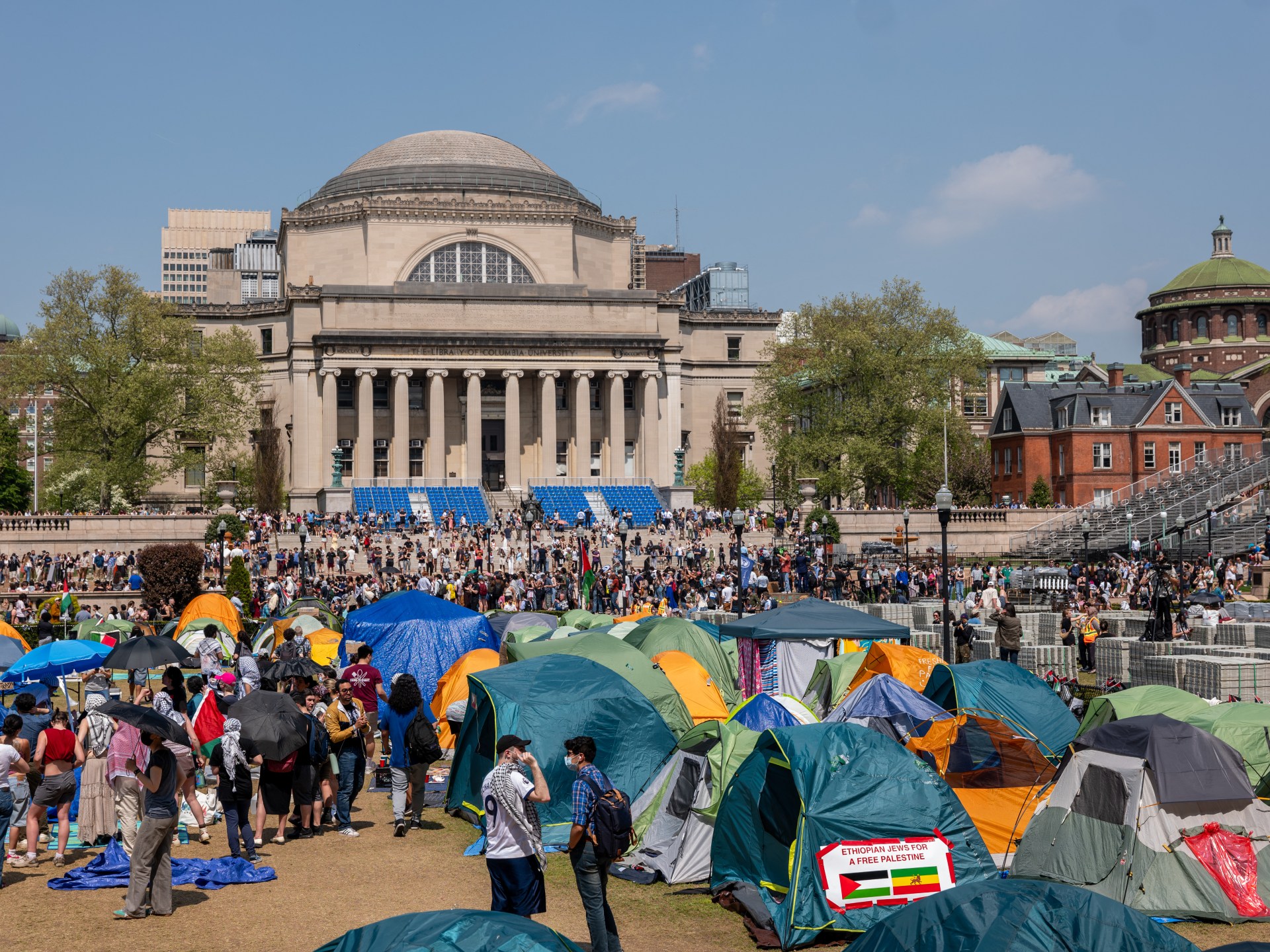
How do the US antiwar protests today differ from those of 1967-1968 | Gaza
- Politics
- June 6, 2024
- No Comment
- 134
Schools are out, summer vacations fixed. But if the past is any guide to the future, United States university campuses come autumn will again erupt in demonstrations with inevitable violence and arrests if Israel continues its war on Gaza.
I covered my first antiwar demonstration on October 21, 1967. Then a 19-year-old cub reporter for a local Washington, DC, radio station, I marched with nearly 100,000 people across the Arlington Memorial Bridge into Virginia and on to the Pentagon. They were a mixed lot. Most just wanted to end the Vietnam War and bring home the more than 380,000 soldiers fighting there. But some seemed to be rooting for the Vietnamese communists to win. A 29-year-old protest leader named Walter Teague, who I came to know, carried a Viet Cong flag. Famed novelist Norman Mailer later profiled Teague in his book Armies of the Night, calling him a longtime “revolutionary” who believed in the communist “liberation” of Vietnam.
I watched US marshals manhandle 700 young people and take them into custody outside the doors of the Pentagon that night. Two years later, I left the US to report the war from Vietnam.
Antiwar activists, like Teague, carrying their Viet Cong flags, gave the administrations of President Lyndon B Johnson and Richard Nixon an excuse to attack the protesters. It allowed them to claim all demonstrators were communist sympathisers who wanted the enemy to win.
Spin ahead 56 years to another generation carrying out antiwar protests in a dozen US cities and on university campuses during the past few months.
If the protesters of 1967-1968 were seen as communist sympathisers, those who protest Israel’s war in Gaza today are portrayed as anti-Semites and terrorist sympathisers.
Radical right Republicans and a segment of the Israel lobby define the narrative, pushing a conflated logic.
The attacks on today’s antiwar demonstrators are magnified in the era of social media and a much more radicalised traditional media.
On May 19, Rupert Murdoch’s New York Post ran a story with the headline “Hamas flag proudly waved at NYC anti-Israel demonstration: ‘Marching for terrorists’.”
Pictures of a single masked figure waving a Hamas flag accompanied the article. “A pro-terror protester proudly waved the Hamas flag at a weekend rally in Brooklyn – in a shocking and disturbing display of solidarity with terrorists,” the Post said. Police moved in, disbanded the protest and arrested a dozen men who appeared to have participated in a radical offshoot of a series of daylong peaceful demonstrations across Brooklyn.
When I reached out to one of those who had marched from the Bay Ridge neighbourhood to the Brooklyn Bridge, he said: “I saw no Hamas flags. I was among about 10,000 people calling on Israel to stop the war in Gaza. There were Jews among our marchers, even Hasidic Jews who for very different reasons hate the [Israeli Prime Minister Benjamin] Netanyahu government. All just wanted a ceasefire, an end to war.”
On May 23, a Republican-led congressional committee summoned three university presidents to question them, or rather lambast them, for allowing anti-Semitism to spread on college campuses.
A North Carolina congresswoman named Virginia Foxx chaired the session and led the attack.
“Suddenly over the course of weeks, … universities have burst into anti-Semitic chaos, … a powder keg of pro-terror campus fervour, a shocking spectacle for the American public,” Foxx read in her opening statement.
While the three college presidents defended their actions in trying to end campus protests peacefully without police intervention, none questioned the committee’s stated premise.
Fox News amplified the exchange: “Congressional hearings accuse university presidents of capitulating to ‘antisemitic, pro-terror encampment organisers’”.
Jonathan Greenblatt, the CEO of the Anti-Defamation League, perhaps the most influential Jewish lobbying group in America, helped set the stage for the narrative by broadening the definition of anti-Semitism in early 2022. He criticised those, including Jews, who spoke in opposition to the Israeli or “Zionist” state. He declared: “Anti-Zionism IS anti-Semitism.”
It has now become difficult to condemn Israeli actions or the Netanyahu government without being labelled an anti-Semite.
With their anti-Zionist slogans and pro-Palestinian sympathies, young people in their encampments at Columbia University in New York or the University of California in Los Angeles had put targets on their backs. The roots of their protests lay in demands to end Israeli military action against Gaza and US government support for it, to stand up for Palestinian rights and to end their suffering. No, the students said, they had not forgotten about the Hamas atrocities of October 7. Were there among them those who held a bias against Jews? Possibly. But Jewish students helped organise sit-ins and were most vocal in denouncing the false equivalency of anti-Zionism and anti-Semitism.
Several Jewish students at Brown University in Providence, Rhode Island, walked out of a speech this year by Greenblatt. They denounced him for embracing “political Zionism”. Such an ideology, they argued, had “negative impacts on the lives of millions”. The students wrote that such Zionism “cannot be separated from the ethnic cleansing of 750,000 Palestinians in 1948, the sustained violence for the last 75-plus years or the current genocide in Gaza.”
Whatever the beliefs of the protesters, they have become, as their parents or grandparents had been in the 1960s, a critical element in a close and bitter presidential campaign.
The radical right aligned with Christian fundamentalists and led by former President Donald Trump now claim to be the true defenders of Israel.
They embraced Netanyahu’s denunciation of student demonstrations in April. They predictably condemned the increasingly large percentage of progressives and Democrats who identify themselves as antiwar and pro-Palestinian rights.
The senior leader of the progressives, 82-year-old Senator Bernie Sanders, came out swinging last month. “No, Mr Netanyahu, it is not anti-Semitic or pro-Hamas to point out that in a little over six months, your extremist government has killed 34,000 Palestinians.”
“I am a Jew whose father’s family was wiped out by Hitler,” Sanders continued, “and I find it outrageous that Netanyahu wants to hide outrageous military behaviour behind the terrible image of anti-Semitism.”
The Gaza war puts US President Joe Biden in a lose-lose position. Sanders warned Biden last month that he may lose young voters. Pollsters reported he may have already lost the Palestinian-American vote in the key battleground state of Michigan. He may also be in danger of losing critical older Jewish voters in Pennsylvania, another battleground state in November’s presidential election.
Unlike 56 years ago, the 2024 election will not be decided by the fractures caused by a foreign war alone. The fractures in today’s America are arguably deeper and more dangerous. But what is remarkable in 21st century America is the ease with which political operatives and their social and mass media supporters set the narrative, distort facts and create false equivalencies to the detriment of all.
The views expressed in this article are the author’s own and do not necessarily reflect Al Jazeera’s editorial stance.
#antiwar #protests #today #differ #Gaza









